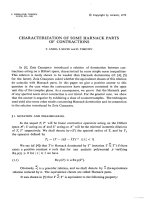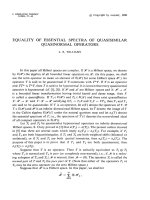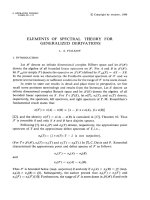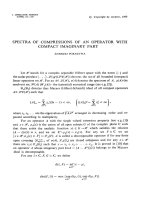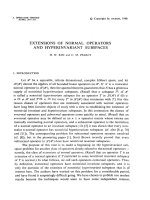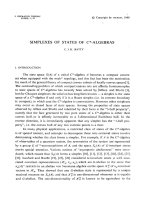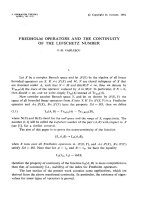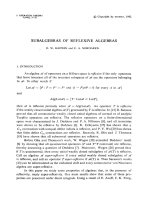Báo cáo toán học: "H-Decompositions of r-graphs when H is an r-graph with exactly 2 edges" ppt
Bạn đang xem bản rút gọn của tài liệu. Xem và tải ngay bản đầy đủ của tài liệu tại đây (112.14 KB, 8 trang )
H-Decompositions of r-graphs when H is
an r-graph with exactly 2 edges
Teresa Sousa
∗
Departamento de Matem´atica, FCT-UNL an d CMA-UNL
Quinta da Torre, 2829-516 Caparica, Portugal
Submitted: Dec 15, 2008; Accepted: Mar 1, 2010; Published: Mar 8, 2010
Mathematics Subj ect Classification: 05C88
Abstract
Given two r-graphs G and H, an H-decomposition of G is a partition of the
edge set of G such that each part is either a single edge or forms a graph isomorphic
to H. The min imum number of parts in an H-decomposition of G is denoted by
φ
r
H
(G). By a 2-edge-decomposition of an r-graph we mean an H-decomposition for
any fixed r-graph H with exactly 2 edges. In the special case where the two edges
of H intersect in exactly 1, 2 or r − 1 vertices these 2-edge-decompositions will be
called bowtie, domino and kite respectively. The value of the function φ
r
H
(n) will
be obtained for bowtie, domino and kite decompositons of r -graphs.
1 Introduction
An hypergraph is a (finite) set V = V (G), called the vertices of G together with a set
E = E(G) of non-empty subsets (of a ny cardinality) of V , called the hyperedges or edges.
When all the edges of a n hyp ergraph are distinct we say t hat the hypergraph is simple.
If in addition all the edges have the same cardinality r 2 then G is said to be a
uniform hypergraph or an r-graph. Thus, graphs are special hypergraphs. The number of
vertices of an hypergraph is its order and is denoted by v(G). The number of edges in an
hypergraph is its size and is denoted by e(G). The complete r-graph on n vertices is the
hypergraph that consists of a ll r-subsets of V and it will be denoted by K
r
n
. We denote
by [n] the set of the first n integers.
Given two r-graphs G and H, with r 2, an H-decomposition of G is a part itio n of
the edge set of G such that each part is either a single edge or forms a graph isomorphic
to H. The minimum number of parts in an H-decomposition of G is denoted by φ
r
H
(G).
∗
This work was partially supported by Financiamento Base 2009 ISFL-1-297 from FCT/MCTES/PT
the electronic journal of combinatorics 17 (2010), #R40 1
Fo r r 2, we are interested in the value of the function
φ
r
H
(n) = max{φ
r
H
(G) | v(G) = n},
which is the smallest number such that any r-graph G of order n admits an H-decom-
position with at most φ
r
H
(n) parts.
In the special case of r = 2, i.e., when we have graphs, the asymptotic value of the
function φ
2
H
(n), simply denoted by φ
H
(n), was obtained by Pikhurko and Sousa [3] for
all graphs H. However, the value of the function φ
r
H
(n) is still open for r 3. We will
present some results about the value of the function φ
r
H
(n) for some special cases of H.
By a 2-edge-decomposition of an r-graph we mean an H-decomposition for any fixed
r-graph H with exactly 2 edges. In the special case where the two edges o f H inter-
sect in exactly 1, 2 or r − 1 vertices these 2-edge-decompositions will be called bowtie,
domino and kite respectively. In this paper the 2-edge-decomposition problem is solved
asymptotically and we will also obtain the exact value φ
r
H
(n) for some special cases of
2-edge-decompositions.
2 2-Edge-De composi t i ons of r-Graphs
We start this section with the following simple result.
Lemma 2.1. For any non-empty r-graph H with m edges and any integer n, we have
φ
r
H
(n)
1
m
n
r
+
m −1
m
ex(n, r, H), (2.1)
where ex (n, r, H) denotes the maximum n umber of edges that an r-graph with n vertices
can have without containin g a copy of H.
Proof. To prove (2.1) remove greedily one by one the edge-sets of H-subgraphs of a given
r-graph G and then remove t he remaining edges. The bound (2.1) follows as at most
ex(n, r, H) parts are single edges.
Let G be an r-graph with vertex set V (G) and edge set E(G). We say that G is
t-colorable if there is a map
c : V (G) → {1, . . . , t}
such that no edge X ∈ E(G) in monochromatic.
Let H be a fixed r-colorable r-graph with m edges. Erd˝os [2] proved that
ex(n, r, H) = o(n
r
).
We have,
φ
r
H
(n) =
1
m
+ o(1)
n
r
. (2.2)
the electronic journal of combinatorics 17 (2010), #R40 2
The upper bound in (2.2 ) follows directly fr om (2.1) and the result of Erd˝os [2] and the
lower bound follows from φ
r
H
(n) φ
r
H
(K
r
n
)
1
m
n
r
.
Observe that the 2-edge-decompo sition problem is asymptotically solved in (2.2) for
r-colorable r-g r aphs.
In this section we will find the exact value φ
r
H
(n) for some special cases of 2-edge-
decompositions. Let H be a fixed r-graph with exactly 2 edges. We will start by proving
that φ
r
H
(n) φ
r
H
(K
r
n
). Thus, it suffices to study 2-edge-decomp ositions of complete r-
graphs. Then, we will also prove that the trivial lower bound
φ
r
H
(K
r
n
)
1
2
n
r
is in fact optimal for bowtie, domino and kite decompositions of r-graphs, fo r some values
of r.
Definition 2.2. Let H be a fixed r-graph with 2 edges and F an H-decomposition of an
r-graph G. We say that F is optimal if it contains exactly φ
r
H
(G) elements.
Theorem 2.3. Let H be a fixed r-graph with 2 edges and G an r-graph with n vertices.
Then,
φ
r
H
(G) φ
r
H
(K
r
n
).
Proof. Let F be an o ptimal H-decomp osition of K
r
n
. We will extract from F an H-
decomposition of G, C, having at most |F| elements.
Let F be an element of F. If F has two edges a nd both are edges of G then we add F
to C. If exactly on edge of F is an edge of G then add that single edge t o C. If the edges
of F are not edges of G we discard F. After every element of F has been considered, the
set C is clearly an H-decomposition of G and we have
φ
r
H
(G) |C| |F| = φ
r
H
(K
r
n
),
as required.
Theorem 2.3 implies that, when H has exactly 2 edges, it suffices to study H-decom-
positions of complete r-graphs . In the sequel, and for the sake of simplicity, the edges of
an r-graph will be written as x
1
···x
r
instead of {x
1
, . . . , x
r
}.
2.1 Bowtie Decomposition of the Complete r-Graph
Theorem 2.4. Let r = 3 and n 5 or 4 r
1
6
√
n. Then any optimal bowtie
decompositio n of the complete r-graph of order n has
1
2
n
r
elements.
Before proving the t heorem we will need to introduce the tools.
the electronic journal of combinatorics 17 (2010), #R40 3
Theorem 2.5 (Dirac 1952, [1]). Every graph with n 3 vertices and minimum degree at
least n/2 has a hamiltonian cycle.
Theorem 2.6 (Tutte 1947, [1]). A graph G has a 1-factor (perfect matchin g) if and
only if odd(G −S) |S| for all S ⊆ V (G), where odd(G − S) denotes the number of odd
components of the graph G −S.
Theorem 2.7 (Ray-Chaudhuri,Wilson 1975, [4]). Let L be a set consisting of s non-
negative integers and let G be an r-graph with n vertices. If |A ∩B| ∈ L for any distinct
edges A, B ∈ E(G), then e(G)
n
s
.
Proof of Theorem 2.4. The lower bound follows immediately, thus it suffices to find a
bowtie decomposition of K
r
n
with
1
2
n
r
elements. Let [n] be the vertex set of K
r
n
. Let
G
r
be the graph with V (G
r
) = E(K
r
n
) and E(G
r
) = {uv | u, v ∈ E(K
r
n
) and |u ∩v| = 1}.
Then, the theorem follows if we prove that G
r
has a Hamiltonian cycle or a matching that
saturates at least v(G
r
) −1 vertices.
Note that G
r
is a connected r
n−r
r−1
-regular graph. For r = 3 and n = 5, 6 we can see
by inspection that G
3
contains a perfect matching. If r = 3 and n ∈ {7, . . . , 11} then
Theorem 2.5 holds so G
3
has a Hamiltonian cycle. Supp ose t hat r = 3 and n 12 or
4 r
1
6
√
n. In this case we will see that Tutte’s Theorem holds. If necessary remove
one vertex fro m V (G
r
) so that we have v(G
r
) even.
Definition 2.8. Let G be an r-graph. The independence number of G, denoted by α(G),
is the maximum number of pairwise non adjacent vertices of G.
Claim 1. α(G
r
)
n
r−1
.
Proof. Let A ⊆ V (G
r
) be an independent set. Then, | A ∩ B| ∈ {0, 2, . . . , r − 1} for all
distinct A, B ∈ A. Considering the r-graph ([n], A) , we have |A |
n
r−1
by Theorem 2.7.
Claim 1 implies tha t fo r every S ⊆ V (G
r
) we have odd(G
r
−S)
n
r−1
. The following
claim completes the proof of the theorem.
Claim 2. |S| odd(G
r
− S), for all S ⊆ V (G
r
).
Proof. L et S ⊆ V (G
r
). If S = ∅ then there is nothing to prove since G
r
is connected.
Assume that S = ∅. Let F
1
, . . . , F
t
be the components of G
r
− S and v
1
, . . . , v
t
be fixed
elements of F
1
, . . . , F
t
respectively.
Assume first that v
1
, . . . , v
t
are pairwise disjoint. Thus, odd(G
r
− S) t n/r. Let
v
1
= x
1
···x
r
and v
2
= y
1
···y
r
. Then, for all w
1
, . . . , w
r−2
∈ [n] − {v
1
∪ v
2
} and for all
i, j ∈ {1, . . . , r} the vertices x
i
y
j
w
1
···w
r−2
are adjacent to both v
1
and v
2
and thus must
be in S. Therefore |S| r
2
n−2r
r−2
−1 (recall that we might have removed one vertex from
V (G
r
)). Easy calculations show that r
2
n−2r
r−2
− 1 n/r odd(G
r
− S) as required.
Now suppo se that there are i, j with 1 i < j t such that |v
i
∩ v
j
| = k for
some k ∈ {2, . . . , r − 1}. Without loss of generality let v
i
= a
1
···a
k
x
k+1
···x
r
and
v
j
= a
1
···a
k
y
k+1
···y
r
. Then, for all w
1
. . . , w
r−1
∈ [n] −{v
i
∪v
j
}, the vertices
a
m
w
1
···w
r−1
and x
p
y
q
w
1
···w
r−2
,
the electronic journal of combinatorics 17 (2010), #R40 4
where 1 m k and p, q ∈ {k + 1, . . . , r}, are adjacent to both v
i
and v
j
and thus must
be in S. Therefore, |S| k
n−2r+k
r−1
+ (r − k)
2
n−2r+k
r−2
−1.
It remains to prove that
k
n −2r + k
r − 1
+ (r − k)
2
n −2r + k
r − 2
− 1
n
r −1
. (2.3)
Let r = 3 and n 12. We have k = 2 and (2.3) holds for n 13. Let us consider the
case n = 12. Then, there is m ∈ [t]−{i, j} such that v
m
−{v
i
∪v
j
} = ∅. Otherwise, for all
m ∈ [t]−{i, j} we have v
m
⊆ v
i
∪v
j
= {a
1
, a
2
, x
3
, y
3
}, but then we have only two choices for
distinct v
m
’s which implies t 4. Let z ∈ v
m
−{v
i
∪v
j
}. Then, for all w ∈ [n]−{v
i
∪v
j
∪v
m
}
the edges a
1
zw are adjacent to both v
i
and v
m
and hence are vertices of S. Note that
these vertices have not been considered before. Since |[n] −{v
i
∪ v
j
∪ v
m
}| n − 7 and
n = 12 we have |S| (n −4)
2
+ (n −7) −1
n
2
t.
Now assume that 4 r
1
6
√
n, that is, n 576. We have,
k
n −2r + k
r −1
+ (r − k)
2
n −2r + k
r − 2
2
n −2r + k
r − 1
2
n −2r
r −1
.
Therefore, to prove (2.3) it is enough to show that
2
n −2r
r −1
n
r −1
. (2.4)
Easy calculations show that to prove (2.4) it is enough to show that
2(n −r + 1) ···(n −3r + 2)
n ···(n −2r + 1)
1. (2.5)
Observe that the following inequalities hold.
2(n −r + 1) ···(n −3r + 2)
n ···(n −2r + 1)
2
n −3r + 2
n
2r
2
n −3r
n
2r
2
1 −
1
2
√
n
2r
2
1 −
1
2
√
n
1
3
√
n
, since r
1
6
√
n.
Since n 576 we have that
2
1 −
1
2
√
n
1
3
√
n
1.
Therefore, inequality (2.5) holds, thus (2.3) is proved.
the electronic journal of combinatorics 17 (2010), #R40 5
2.2 Domino Decomposition of the Complete 4-graph
Recall that a domino decomposition of an r-g raph is a decomp osition o f its edge set into
a fixed r-graph with two edges that intersect in exactly two vertices and single edges.
Theorem 2.9. Any optimal domino decomposition of the complete 4 - graph with n 6
vertices has
1
2
n
4
elements.
Proof. Clearly any optimal domino decomposition of K
4
n
has at least that many elements.
We will now prove by induction that this lower bound is optimal. Let n = 6. Then
{1234, 12 56},{1235, 2456}, {124 5, 2346}, {1246, 34 56},
{1345, 23 56}, {1346, 2345 }, {1236, 1456}, {1356}
is a domino decomposition of K
4
6
. Let n 7 and a ssume that the result holds for n −1.
Let F be an optimal domino decomposition of K
4
n−1
. The result will follow if we show
how to extend F into a domino decomposition of K
4
n
with the prescribed number of
elements. Observe that E := E(K
4
n
) −E(K
4
n−1
) = {e ∪{ n} | e ∈ E(K
3
n−1
)} and a domino
decomposition of E is the same as a bowtie decomposition of K
3
n−1
. Let B be an optimal
bowtie decomposition of K
3
n−1
and F
′
its extension to a domino decomposition of E. If
K
4
n−1
has an even number of edges then F ∪ F
′
is clearly a domino decomposition of K
4
n
with the required number of elements. Now suppose that K
4
n−1
has an odd number of
edges. In this case F has an element that is a single edge, say xyzw. If K
3
n−1
has an even
number of edges then we are done as before. So supp ose that K
3
n−1
has an odd number
of edges. Then B has an element that is a single edge. From the proof of Theorem 2.4
it follows that we can a lways choose B such that xya, f or some a ∈ [n − 1] − {x, y, z, w}
is the single edge in B. Then, F ∪ F
′
∪ {xyzw, xyan} is a domino decomposition of K
4
n
with
1
2
n
4
elements.
2.3 Kite Decompositions of the complete 3-Graph and 4-Graph
Recall that a kite decomposition of an r-graph is a decomposition of its edge set into a
fixed r-graph with two edges that intersect in exactly r − 1 vertices and single edges.
Theorem 2.10. Any optimal kite decomposition of the complete 3-graph with n 4
vertices has
1
2
n
3
elements.
Proof. The lower bound follows immediately, thus it suffices to find a kite decompo-
sition of K
3
n
with
1
2
n
3
elements. This is done by induction on n. If n = 4 then
{123, 234}, {124, 134}
is a kite decomposition of K
3
4
. Let n 5 and assume that the
result holds for n − 1. Let F be an optimal kite decomposition of K
3
n−1
. The result
follows by induction if we show how to extend F into a kite decomposition of K
3
n
with
the electronic journal of combinatorics 17 (2010), #R40 6
the required number of elements. We first write E(K
3
n
) −E(K
3
n−1
) as follows:
12n 13n 14n ··· 1(n −1)n
23n 24n ··· 2(n −1)n
34n ··· 3(n −1)n
···
(n −3)(n −2)n (n −3)(n −1)n
(n −2)(n −1)n
To proceed we have to consider two different cases.
Case I: Assume that K
3
n−1
has an even number of edges. Then all the elements of F have
two edges, thus it suffices to pair the edges above. This can be done easily by pairing
the edges in the same row, starting from left to right, so if a row has an odd number
of elements then its element in the last column will be left unpaired. We end up this
procedure by pairing the elements left in the last column, leaving exactly one single edge
if and only if K
3
n
has an odd number of edges.
Case II: Assume that K
3
n−1
has an odd number of edges. Then F has an element that
is a single edge, say xyz with x < y < z. We first pair this edge with the edge xyn and
then proceed as in Case I.
Theorem 2.11. Any optimal kite decomposition of the complete 4-graph with n 5
vertices has
1
2
n
4
elements.
Proof. The lower bound follows immediately, thus it suffices to find a kite decompo-
sition of K
4
n
with
1
2
n
4
elements. This is done by induction on n. If n = 5 then
{1234, 12 45}, {1235, 1345 }, {2345}
is a kite decomposition of K
4
5
. Let n 6 and as-
sume that the result holds for n − 1. Let F be an optimal kite decomposition of K
4
n−1
.
The result follows by induction if we show how to extend F into a a kite decomposition
of K
4
n
. We first write E(K
4
n
) −E(K
4
n−1
) in n −3 groups as follows:
M
1
: 123n 124n 125n ··· 12(n −1)n
134n 135n ··· 13(n −1)n
···
1(n −3)(n −2)n 1(n −3)(n −1)n
1(n −2)(n −1)n
M
2
: 234n 235n ··· 23(n −1)n
245n ··· 24(n −1)n
···
2(n −3)(n −2)n 2(n −3)(n −1)n
2(n −2)(n −1)n
.
.
.
M
n−3
: (n −3)(n −2)(n −1)n
the electronic journal of combinatorics 17 (2010), #R40 7
To proceed we have to consider two different cases.
Case I: K
4
n−1
has an even number of edges. Then all the elements of F have two edges,
thus it suffices to pair the edges above. This can be done using the following procedure.
Fo r 1 i n − 3, we consider the group M
i
and pair the edges in the same
row, starting from left to right, so if a row has an o dd number of elements
then its element in the last column will be left unpaired. We then pair t he
elements left in the last column starting from top to bottom.
After all groups have been considered all the edges left are of the form x(n −2)(n −1)n,
with x ∈ [n]. We finish this procedure by pairing these edges, leaving exactly one single
edge if and only if K
4
n
has an odd number of edges.
Case II: Assume that K
4
n−1
has an odd number of edges. Then F has an element that is
a single edge, say xyzw with x < y < z < w. We first pair this edge with the edge xyzn
and then proceed as in Case I.
Acknowledgement. The author thanks Oleg Pikhurko for helpful discussions and
comments.
References
[1] Reinhard Diestel. Graph Theory. Springer–Verlag, 2nd edition, 2000.
[2] P. Erd˝os. On extremal problems of graphs and g eneralized graphs. Israel J. Math.,
2:183–190, 1964.
[3] Oleg Pikhurko and Teresa Sousa. Minimum H-decompositions of graphs. Journal of
Combinatorial Theory, B, 97:1041–1055, 2007.
[4] Dij en K. Ray-Chaudhuri and Richard M. Wilson. On t-designs. Osaka J. Math.,
12(3):737–744, 1975.
the electronic journal of combinatorics 17 (2010), #R40 8


